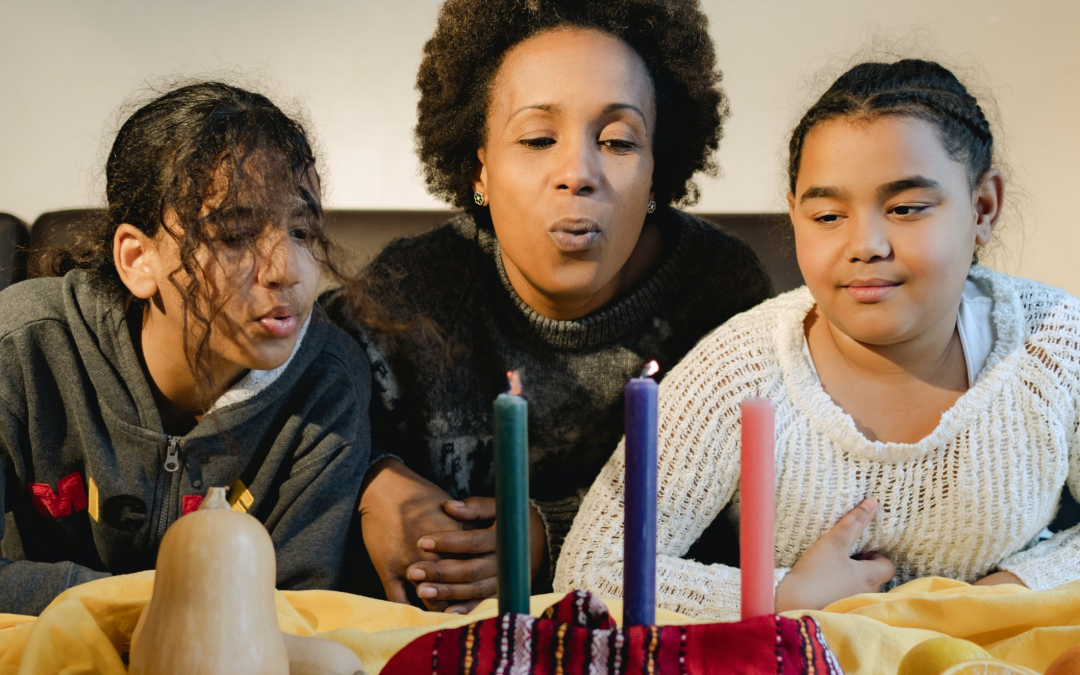As the year winds down, the holiday season is on everyone’s mind. With so many holidays celebrated in different ways, midwinter can provide a wonderful opportunity to learn about different cultures and traditions. Though Christmas is the most widely celebrated winter holiday in America, giving girls the opportunity to understand and share in the celebration of other holidays can be a great way to increase cultural understanding and help girls from all backgrounds feel included and valued. Here are a few winter holidays you may want to help girls learn about!
Kwanzaa
Observed from December 26th to January 1st, Kwanzaa (meaning “first” in Kiswahili) is a harvest celebration created by Dr. Maulana Karenga in 1966 to honor African American community, history, and values. The seven day festival often includes family gatherings with lots of delicious food and gifts. The seven candles on the Kinara (candleholder) represent values of unity (umoja), self-determination (kujichagulia), collective work and responsibility (ujima), cooperative economics (ujamaa), purpose (nia), creativity (kuumba), and faith (imani). To help girls understand the significance of Kwanzaa, try reading books about Kwanzaa, learning about African American history, talking about what the values represented on the Kinara mean to them, or discussing how traditions, holidays and celebrations create community.
Hanukkah
Hanukkah is a Jewish celebration of identity that begins on the 25th day of Kislev, on the Hebrew calendar and is usually observed in November or December in America. (The dates align a bit differently each year.) Often called the Festival of Lights, Hanukkah dates back more than 2000 years and honors the victory of the Jewish Maccabean rebels over the ancient Syrian King Antiochus who tried to outlaw Judaism. Modern Hanukkah celebrations can include lighting a menorah (candle holder), family gatherings, gifts, and games of dreidel, a small spinning top. Traditional foods include potato pancakes called latkes, and jelly donuts (sufganiyot). Troops learning about Hanukkah may want to make latkes and applesauce, paint dreidels, read books about the Hanukkah story, or talk about times when it’s been difficult to be themselves and how they deal with those challenges.
Bodhi Day
Bodhi Day is a Buddhist festival honoring the day when the historical Buddha, Siddhartha Gautama, gained enlightenment while meditating under a bodhi tree.
Observed on different dates due to differing calendars and traditions, Bodhi day is observed throughout the world but is especially popular in China, Korea, Japan, and Vietnam. Many practicing Buddhists celebrate by decorating trees with colorful lights and beads, meditating, sharing meals, and performing acts of kindness. Your troop can learn about Bodhi Day with tree themed arts and crafts, learning about meditation, spending time in nature, or having conversations about how quiet times of reflection can help our understanding of ourselves and the world around us.
Yule
Many modern Christmas traditions are actually rooted in customs that originated with the pagan celebration of Yule, which honors the Winter Solstice on December 21st. In the northern hemisphere, the Winter solstice is the time when the south pole is tilted closest to the sun. Many cultures (as well as scientists!) recognize this as a time when the amount of daylight begins to increase as we make the journey from long winter nights to long summer days. Yule is celebrated by lighting candles that honor the return of light, by decorating with evergreen branches and trees, and by giving thanks to nature for the turn of the seasons. Your troop can enjoy the solstice and celebrate Yule by learning why seasons happen and the difference between a solstice and an equinox, by taking a walk in nature and seeing things that are still green or growing even in the winter, with an evening of stargazing (bring hot chocolate!) on the year’s longest night, by making candles, or by writing their hopes for the coming year and discussing what returning light might mean to them.
These are just a few of the dozens of winter holidays celebrated throughout the world, but they can be a wonderful entry point into expanding cultural understanding with your Girl Scout troop. It can be fun to explore traditions through stories, food, music, and crafts and discover the similarities and differences in these practices. Of course it’s always important to be respectful of everyone’s traditions within your troop, and outside. Remember that religious objects are not toys, and traditional garments are not costumes. If you’re uncertain how to explore a holiday respectfully with your troop, reach out to the community that celebrates it locally. You could arrange a great field trip and make new friends. (Plus you might get to enjoy some delicious holiday treats!) However you celebrate, happy holidays!

Tara Brewster—Tara Brewster is the Marketing and Communications Project Coordinator for Girl Scouts of Northern California. Tara received her MBA in 2019 from California Baptist University. She also received her BA in Political Science from the same university in 2014. During her adolescent years she was also a Girl Scout in the Southern California Region. Tara firsthand understands the dedication that is involved with being a Girl Scout. In her free time, she enjoys spending as much time with her young son, and you can also catch her on your Peloton Leaderboard.

Molly Conway—Molly Conway is a writer living in rural Kentucky. She has been published by (Man) Repeller, The Forward, Sojourners, Grateful, and USA Today. When she’s not writing, Molly can usually be found fixing up an old farmhouse with her husband, working in the garden, or exploring the woods with her canine sidekick, Bialy.


